2012 Lexus LFA tire type
[x] Cancel search: tire typePage 183 of 420
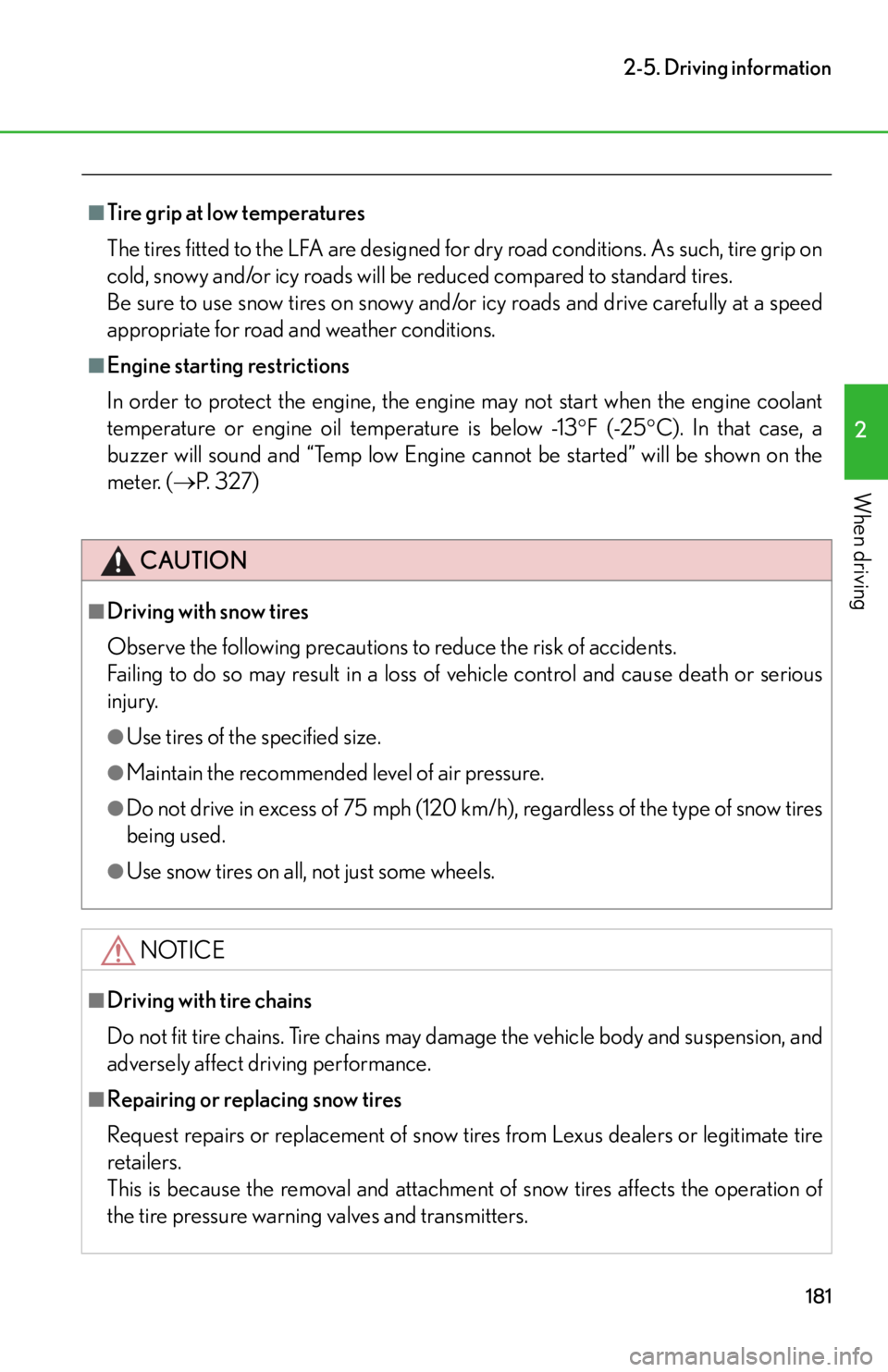
181
2-5. Driving information
2
When driving
■Tire grip at low temperatures
The tires fitted to the LFA are designed for dry road conditions. As such, tire grip on
cold, snowy and/or icy roads will be reduced compared to standard tires.
Be sure to use snow tires on snowy and/or icy roads and drive carefully at a speed
appropriate for road and weather conditions.
■Engine starting restrictions
In order to protect the engine, the engine may not start when the engine coolant
temperature or engine oil temperature is below -13 F (-25C). In that case, a
buzzer will sound and “Temp low Engine cannot be started” will be shown on the
meter. ( P. 3 2 7 )
CAUTION
■Driving with snow tires
Observe the following precautions to reduce the risk of accidents.
Failing to do so may result in a loss of vehicle control and cause death or serious
injury.
●Use tires of the specified size.
●Maintain the recommended level of air pressure.
●Do not drive in excess of 75 mph (120 km/h), regardless of the type of snow tires
being used.
●Use snow tires on all, not just some wheels.
NOTICE
■Driving with tire chains
Do not fit tire chains. Tire chains may da mage the vehicle body and suspension, and
adversely affect driving performance.
■Repairing or replacing snow tires
Request repairs or replacement of snow ti res from Lexus dealers or legitimate tire
retailers.
This is because the removal and attachment of snow tires affects the operation of
the tire pressure warning valves and transmitters.
Page 275 of 420
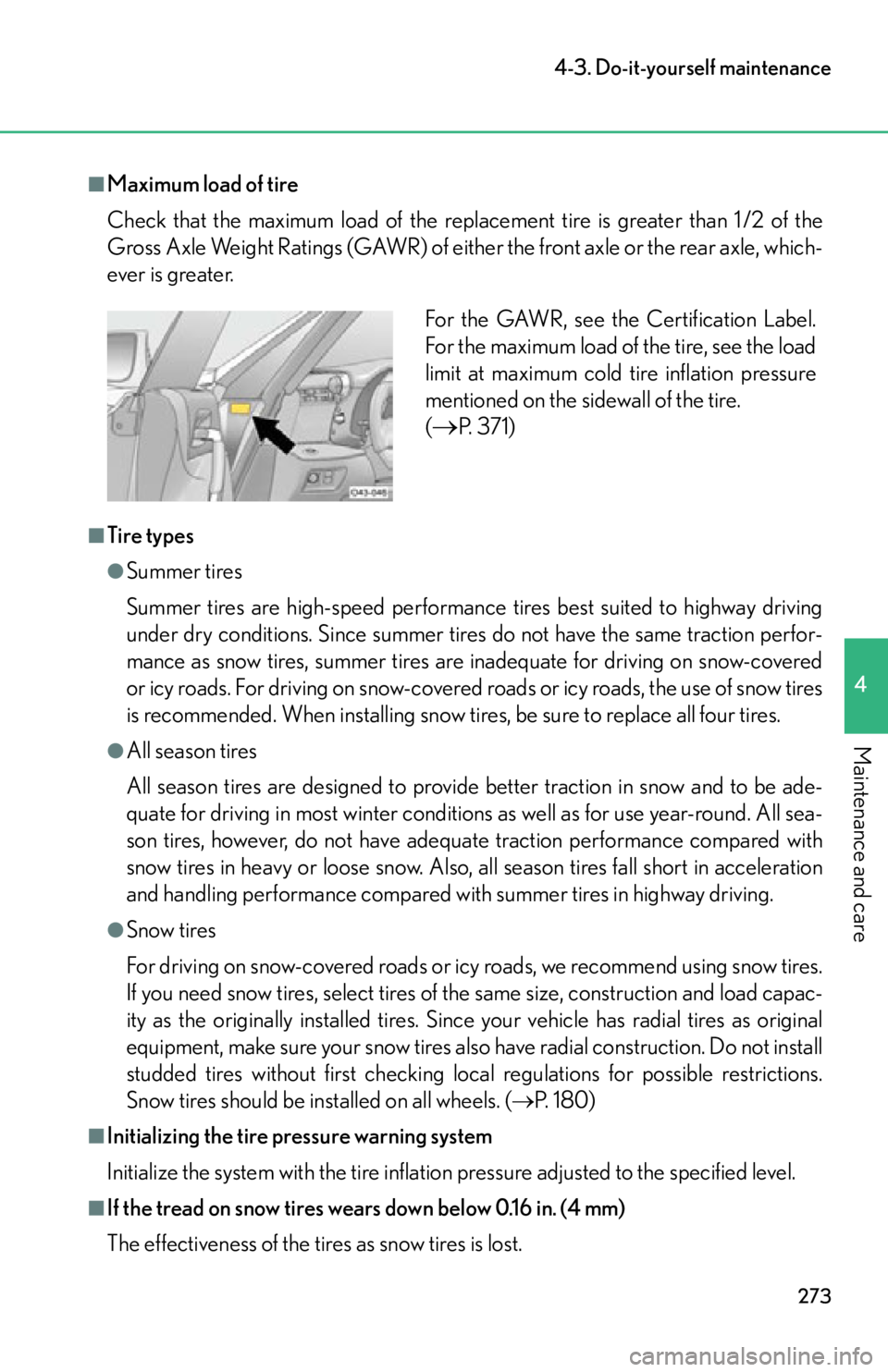
273
4-3. Do-it-yourself maintenance
4
Maintenance and care
■Maximum load of tire
Check that the maximum load of the replacement tire is greater than 1 /2 of the
Gross Axle Weight Ratings (GAWR) of either the front axle or the rear axle, which-
ever is greater.
■Tire types
●Summer tires
Summer tires are high-speed performance tires best suited to highway driving
under dry conditions. Since summer tires do not have the same traction perfor-
mance as snow tires, summer tires are inadequate for driving on snow-covered
or icy roads. For driving on snow-covered roads or icy roads, the use of snow tires
is recommended. When installing snow tires, be sure to replace all four tires.
●All season tires
All season tires are designed to provide better traction in snow and to be ade-
quate for driving in most winter conditions as well as for use year-round. All sea-
son tires, however, do not have adequate traction performance compared with
snow tires in heavy or loose snow. Also, al l season tires fall short in acceleration
and handling performance compared with summer tires in highway driving.
●Snow tires
For driving on snow-covered roads or ic y roads, we recommend using snow tires.
If you need snow tires, select tires of the same size, construction and load capac-
ity as the originally installed tires. Since your vehicle has radial tires as original
equipment, make sure your snow tires also have radial construction. Do not install
studded tires without first checking local regulations for possible restrictions.
Snow tires should be installed on all wheels. ( P. 1 8 0 )
■Initializing the tire pressure warning system
Initialize the system with the tire inflatio n pressure adjusted to the specified level.
■If the tread on snow tires wears down below 0.16 in. (4 mm)
The effectiveness of the tires as snow tires is lost.
For the GAWR, see the Certification Label.
For the maximum load of the tire, see the load
limit at maximum cold tire inflation pressure
mentioned on the sidewall of the tire.
(
P. 3 7 1 )
Page 308 of 420
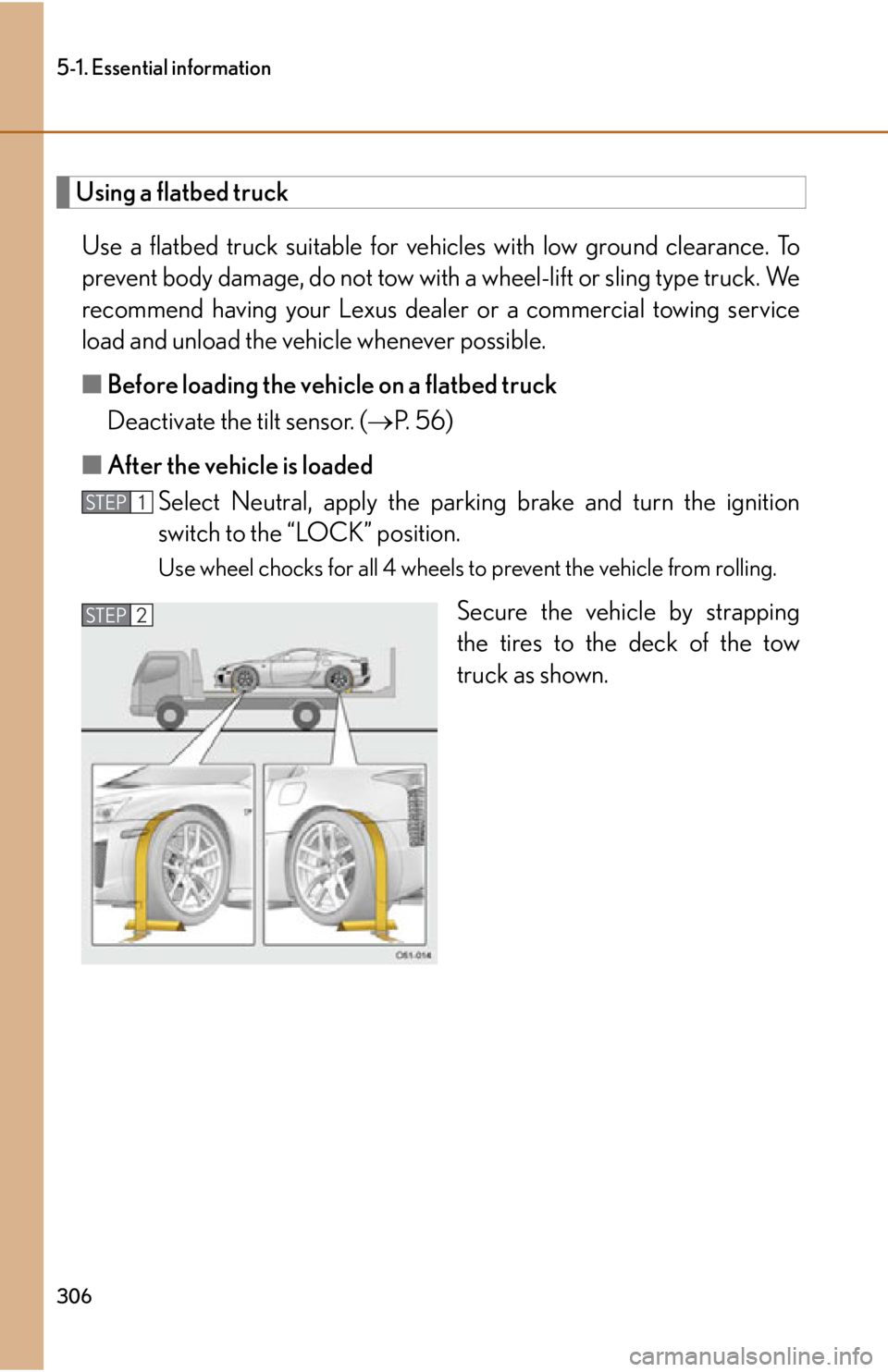
306
5-1. Essential information
Using a flatbed truckUse a flatbed truck suitable for vehicles with low ground clearance. To
prevent body damage, do not tow with a wheel-lift or sling type truck. We
recommend having your Lexus dealer or a commercial towing service
load and unload the vehicle whenever possible.
■ Before loading the vehicle on a flatbed truck
Deactivate the tilt sensor. ( P. 56)
■ After the vehicle is loaded
Select Neutral, apply the parking brake and turn the ignition
switch to the “LOCK” position.
Use wheel chocks for all 4 wheels to prevent the vehicle from rolling.
Secure the vehicle by strapping
the tires to the deck of the tow
truck as shown.
STEP1
STEP2
Page 320 of 420

318
5-2. Steps to take in an emergency
■If the tire pressure warning system is not functioning
The tire pressure warning system will be disabled in the following conditions:
(When the condition becomes normal, the system will work properly.)
●If tires not equipped with tire pressure warning valves and transmitters are used
●If the ID code on the tire pressure warning valves and transmitters is not regis-
tered in the tire pressure warning computer
●If the tire inflation pressure is 73 psi (500 kPa, 5.1 kgf/cm2 or bar) or higher
The tire pressure warning system may be disabled in the following conditions:
(When the condition becomes normal, the system will work properly.)
●If electronic devices or facilities using similar radio wave frequencies are nearby
●If a radio set at similar frequencies is in use in the vehicle
●If there is a lot of snow or ice on the vehicle, particularly around the wheels or
wheel housings
●If non-genuine Lexus wheels are used (Even if you use Lexus wheels, the tire
pressure warning system may not work properly with some types of tires.)
●If a tire is repaired with the emergency tire puncture repair kit
■If the tire pressure warning light comes on after flashing frequently for 1 minute
If the tire pressure warning light comes on after flashing frequently for 1 minute
when the ignition switch is turned to th e “ON” position, have it checked by your
Lexus dealer.
■Customization that can be configured at Lexus dealer
The vehicle speed linked seat belt reminder buzzer can be disabled.
(Customizable features P. 383)
Page 342 of 420

340
5-2. Steps to take in an emergency
■Sealant
●One tire can be repaired using the bottle of sealant stored in the emergency tire
puncture repair kit.
●The sealant can be used when the outside temperature is from -22°F (-30°C)
to 140°F (60°C).
●When the outside temperature is low, the viscosity of the sealant becomes high
and it will be more difficult to inject th e sealant. In this case, warm the sealant in
the vehicle before using it.
●The sealant has a limited lifespan. The expi ration date is marked on the bottle.
The sealant should be replaced before the expiration date. Contact your Lexus
dealer.
●If the sealant gets on your clothes, it may stain.
●After using the sealant, bring the empty bottle of sealant to your Lexus dealer
and purchase a new bottle. Keep the ne w bottle of sealant in your vehicle.
■Compressor
●The compressor is a pneumatic filling type for passenger vehicles.
●When the compressor is operating, a loud operating noise will be produced.
This does not indicate a malfunction.
■The wheel of a tire that has been repaired
If you remove the sealant adhering to the wheel with a rag, you can reuse the wheel.
■The valve of a tire that has been repaired
●After a tire is repaired with the emergency tire puncture repair kit, the tire pres-
sure warning valve and transm itter should be replaced.
●After a tire is repaired with the emergency tire puncture repair kit, even if the
tire inflation pressure is at the recommended level, the tire pressure warning
light may come on/flash.
Page 344 of 420

342
5-2. Steps to take in an emergency
NOTICE
■Vehicles with a flat tire
Do not continue driving with a flat tire.
Driving even a short distance with a flat tire can damage the tire and the wheel
beyond repair.
■When performing an emergency repair
Perform the emergency repair without removing the nail or screw that has punc-
tured the tread of the tire. If the object th at has punctured the tire is removed, the
repair using the sealant in the emergenc y tire puncture repair kit may fail.
■When fixing the flat tire
●Do not put the valve core on dirty ground or in the sand.
Store it in a clean place.
●Do not remove the inside cap of the sealant bottle.
●Turn the valve core tool with your hand when screwing it in. If you use another tool
in conjunction with the valve core tool, damage may occur.
●Do not operate the compressor continuously for more than 10 minutes. The
motor may overheat and be damaged. Le t the compressor cool before using it
again.
■Compressor precautions
●The compressor power source should be 12 V DC suitable for vehicle use.
Do not connect the compressor to 24 V DC or any other power source.
●The compressor is an oil-less type. Do not lubricate with oil.
●If the compressor does not operate properly or becomes hot, it may be over-
heated. Turn off the switch and leave the compressor to cool down for at least 30
minutes.
●The compressor is not waterproof. Make sure that the compressor is not exposed
to water, such as when it is being used in the rain.
●Do not put the compressor directly onto dusty ground such as sand at the side of
the road. If the compressor vacuums up dust etc., a malfunction may occur.
●Do not disassemble or modify the compre ssor. Do not subject parts such as the
air pressure indicator to impacts. This may cause a malfunction.
Page 373 of 420
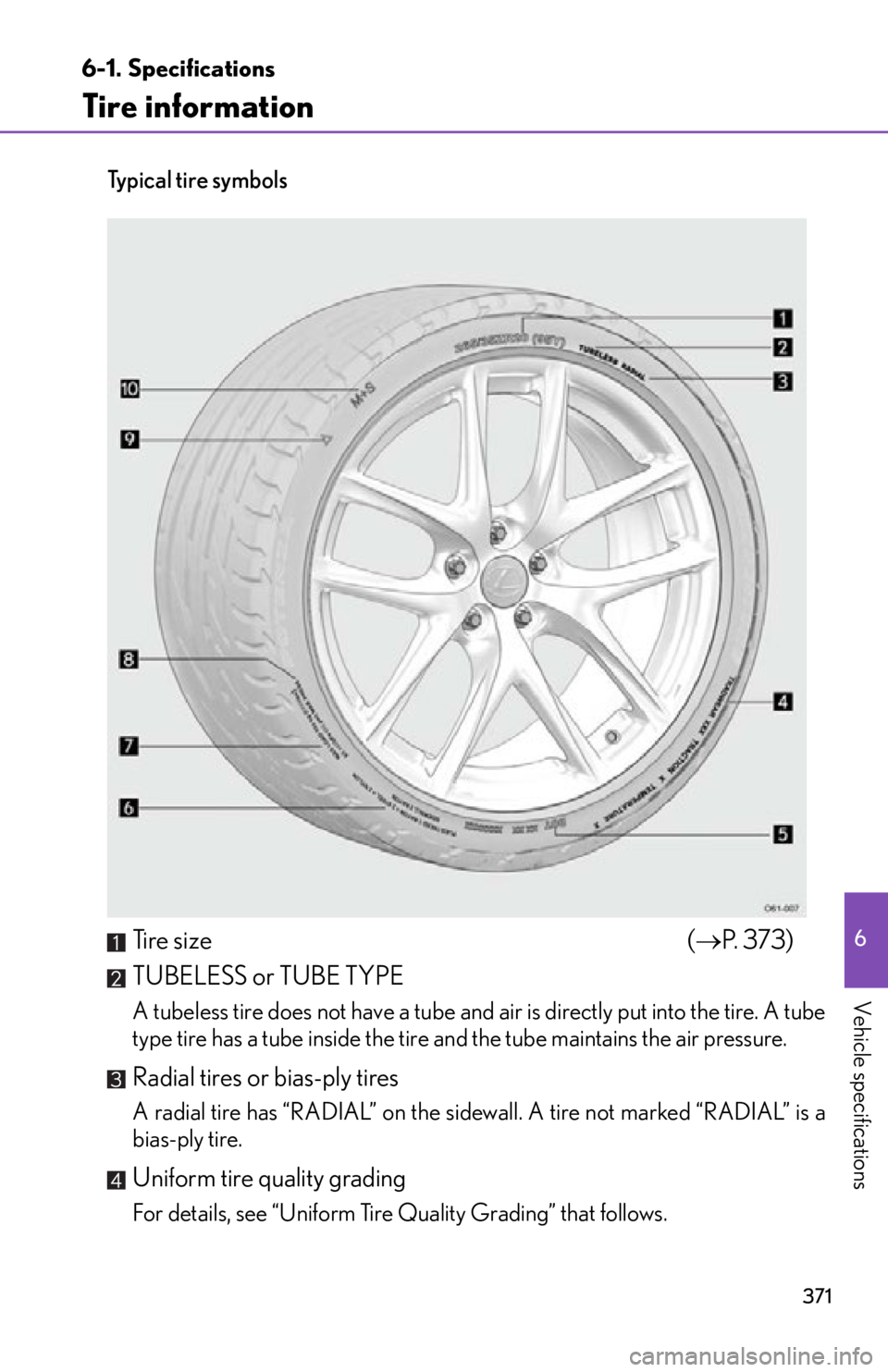
371
6-1. Specifications
6
Vehicle specifications
Tire information
Ty p i c a l t i r e s y m b o l s
Ti r e s i z e( P. 3 7 3 )
TUBELESS or TUBE TYPE
A tubeless tire does not have a tube and air is directly put into the tire. A tube
type tire has a tube inside the tire and the tube maintains the air pressure.
Radial tires or bias-ply tires
A radial tire has “RADIAL” on the sidewall. A tire not marked “RADIAL” is a
bias-ply tire.
Uniform tire quality grading
For details, see “Uniform Tire Quality Grading” that follows.
Page 374 of 420
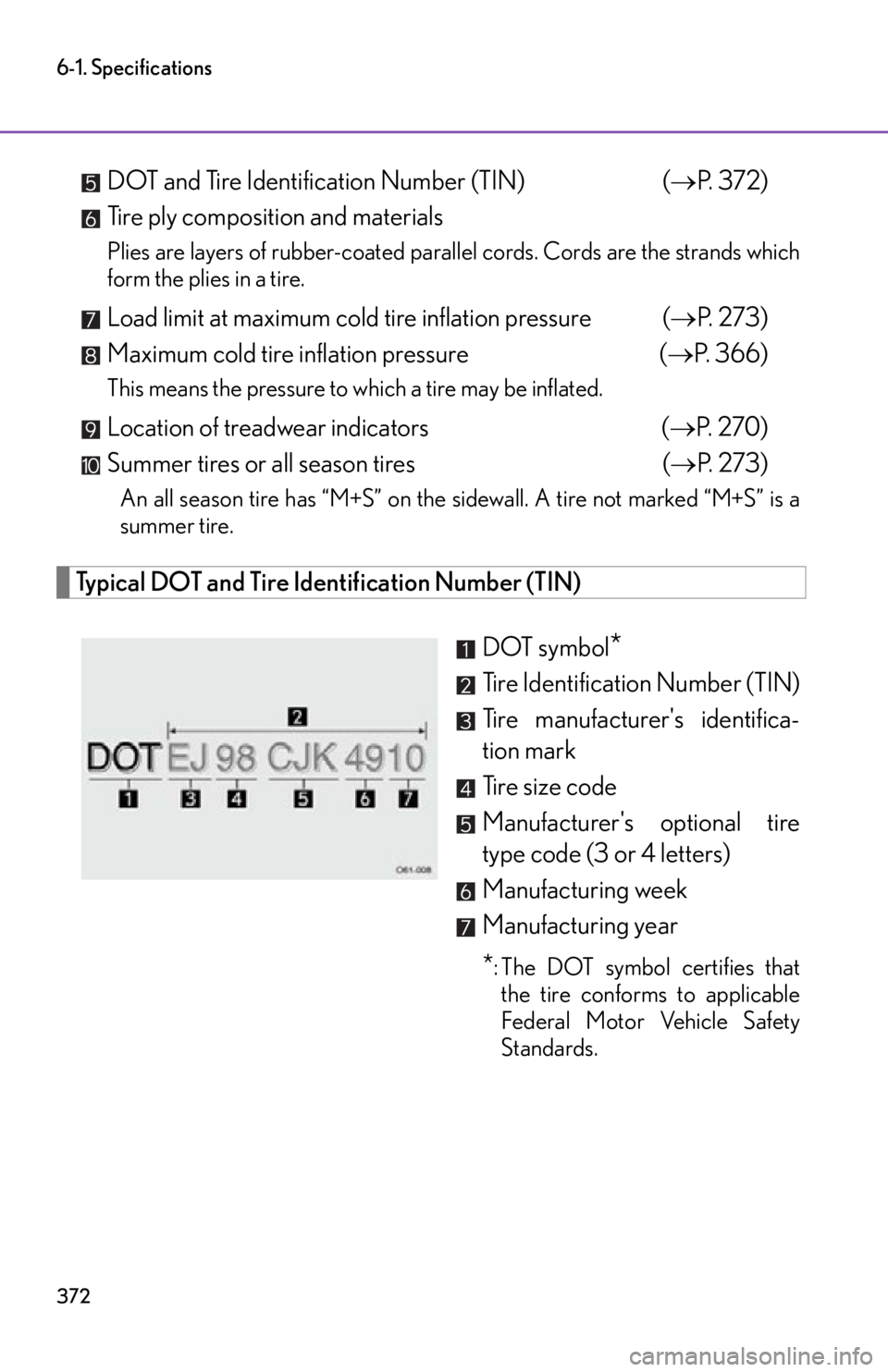
372
6-1. Specifications
DOT and Tire Identification Number (TIN)(P. 3 7 2 )
Tire ply composition and materials
Plies are layers of rubber-coated parallel cords. Cords are the strands which
form the plies in a tire.
Load limit at maximum cold tire inflation pressure ( P. 273)
Maximum cold tire inflation pressure ( P. 366)
This means the pressure to which a tire may be inflated.
Location of treadwear indicators ( P. 270)
Summer tires or all season tires ( P. 273)
An all season tire has “M+S” on the sidewall. A tire not marked “M+S” is a
summer tire.
Typical DOT and Tire Identification Number (TIN)
DOT symbol
*
Tire Identification Number (TIN)
Tire manufacturer's identifica-
tion mark
Tire size code
Manufacturer's optional tire
type code (3 or 4 letters)
Manufacturing week
Manufacturing year
*: The DOT symbol certifies thatthe tire conforms to applicable
Federal Motor Vehicle Safety
Standards.